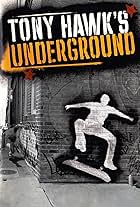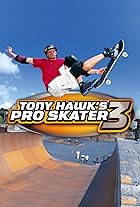Tony Hawk creates a team called Project 8 and comprises of eight skaters. The player character starts ranked 200th and by completing challenges and goals, he will improve his ranking constan... Read allTony Hawk creates a team called Project 8 and comprises of eight skaters. The player character starts ranked 200th and by completing challenges and goals, he will improve his ranking constantly.Tony Hawk creates a team called Project 8 and comprises of eight skaters. The player character starts ranked 200th and by completing challenges and goals, he will improve his ranking constantly.
- Awards
- 1 win
Photos
Bam Margera
- Bam Margera
- (voice)
Bob Burnquist
- Bob Burnquist
- (voice)
Daewon Song
- Daewon Song
- (voice)
Dustin Dollin
- Dustin Dollin
- (voice)
Lyn-z Adams Hawkins
- Lyn-z Adams Hawkins
- (voice)
- (as Lyn-z Adams)
Mike Vallely
- Mike Vallely
- (voice)
Nyjah Huston
- Nyjah Huston
- (voice)
Paul Rodriguez
- Paul Rodriguez
- (voice)
Rodney Mullen
- Rodney Mullen
- (voice)
Ryan Sheckler
- Ryan Sheckler
- (voice)
Adam Jennings
- Custom Skater
- (voice)
- …
Drew Massey
- Dad
- (voice)
- (as Andrew Massey)
Ben Diskin
- Local Skater
- (voice)
- Director
- Writer
- All cast & crew
- Production, box office & more at IMDbPro
Storyline
Did you know
- ConnectionsFeatured in The Seeker: The Dark Is Rising (2007)
- SoundtracksAt the Helm
Performed by Hieroglyphics
Courtesy of Hieroglyphics Imperium
Written by Del the Funky Homosapien (as Teren 'Del' Jones), 50%, Domino (as Damien 'Domino' Siguenza)
Featured review
The eighth installment of the Tony Hawk series of skateboarding, Tony Hawk's Project 8 is an okay, as well as underrated, entry that actually changes up how the game is played.
In this game, Tony Hawk arrives at an unnamed fictional town filled with undiscovered skating talent. After discovering that fact. He decides to hold a competition where the eight best skaters would be part of a new venture called Project 8. Creating your own skater, you become the 200th skateboarder to enter this competition, and therefore, you must rise in the ranks by completing goals, opening up new areas, and completing challenges.
For this game, everything is changed. The main mode goes back to the career mode style of the first four games, which is a far cry to the story-driven approach to games like Tony Hawk's Underground and Tony Hawk's American Wasteland. Basically, depending on the version you play, the game is different. PS2, PSP, and Xbox have less content while requiring players to choose their levels from the pause menu, while the Xbox 360 and PS3 ports have more content and connect the levels into one open world similar to how American Wasteland's Story Mode was done (only it does away with the tunnels that disguise the loading to load the new area). However, the main difference with the ports are its difficulty, as the Xbox 360 and PS3 are a lot harder due to having some different goals, while the other ports are a lot easier.
Speaking of the goals, they have been greatly revamped. The ability to select game difficulty has been removed, and now, the difficulties of AM, Pro, and Sick are recycled to most of the goals as different objectives, with AM requiring minimum effort while Sick requires you to go all the way, be it doing an entire line in one combo, or getting a high score that requires you to learn to make combos. Also, classic mode returns, and is implemented into the story, and like the goals, also fall under the three goal rule (with AM requiring just four goals to be completed, Pro requiring seven, and Sick requiring all ten), and brings back classic goals like collecting S-K-A-T-E and C-O-M-B-O while also making new goals that make use of the levels.
Also, as you complete goals, you unlock more challenges with only one goal or are made up of multiple goals. Some of those are actually challenges that, when completed, will open up more of the world, and then there are challenges like competitions, demos (only in X360 and PS3), and the pro challenges, where pro skaters like Bam Margera, Daewon Song, Bob Burnquist, and Rodney Mullen will put you through various challenges (some of them introducing the events or even new gameplay mechanics).
For gameplay, most of the features that were in THUG2 and THAW are back. One of the new additions is Nail the Trick, which when activated by buttons or launching off a platform with a nail icon, the game zooms in on your skater's feet and board, and using the two analog sticks, you can control the feet to flip and spin the board. Also, exclusive to the Xbox 360 and PS3 version is the ability to manually bail from your board, which is needed for certain goals that require you rack up a hefty hospital bill (but thankfully, your character will recover quickly from his damages). Also, some citizens will like your skating and when stoked, they will pay you Stokens, which can be used at an in-game shop to buy new skateboard deck graphics and special tricks.
However, having played the Xbox 360 and PSP versions, I can see various issues I had. One of those is the fact that reaching certain rankings has you get a call, where someone tells you information like when a level-opening goal is now available to attempt. However, it gets annoying when Jason Lee calls you whenever you hit a rank just to congratulate you on getting a company to sponsor you or to tell you when a pro challenge is available, as they have a video attached to them. Also, some of the goals can be frustrating (especially that goal where you have to sneak into the City Center's building to steal codes while dealing with lasers that sound an alarm when crossed, and require you to wallride panels to disable them). This game is an okay title when you get through the difficulty and annoyances, but the PS2, PSP, and Xbox are the only ports I can recommend.
In this game, Tony Hawk arrives at an unnamed fictional town filled with undiscovered skating talent. After discovering that fact. He decides to hold a competition where the eight best skaters would be part of a new venture called Project 8. Creating your own skater, you become the 200th skateboarder to enter this competition, and therefore, you must rise in the ranks by completing goals, opening up new areas, and completing challenges.
For this game, everything is changed. The main mode goes back to the career mode style of the first four games, which is a far cry to the story-driven approach to games like Tony Hawk's Underground and Tony Hawk's American Wasteland. Basically, depending on the version you play, the game is different. PS2, PSP, and Xbox have less content while requiring players to choose their levels from the pause menu, while the Xbox 360 and PS3 ports have more content and connect the levels into one open world similar to how American Wasteland's Story Mode was done (only it does away with the tunnels that disguise the loading to load the new area). However, the main difference with the ports are its difficulty, as the Xbox 360 and PS3 are a lot harder due to having some different goals, while the other ports are a lot easier.
Speaking of the goals, they have been greatly revamped. The ability to select game difficulty has been removed, and now, the difficulties of AM, Pro, and Sick are recycled to most of the goals as different objectives, with AM requiring minimum effort while Sick requires you to go all the way, be it doing an entire line in one combo, or getting a high score that requires you to learn to make combos. Also, classic mode returns, and is implemented into the story, and like the goals, also fall under the three goal rule (with AM requiring just four goals to be completed, Pro requiring seven, and Sick requiring all ten), and brings back classic goals like collecting S-K-A-T-E and C-O-M-B-O while also making new goals that make use of the levels.
Also, as you complete goals, you unlock more challenges with only one goal or are made up of multiple goals. Some of those are actually challenges that, when completed, will open up more of the world, and then there are challenges like competitions, demos (only in X360 and PS3), and the pro challenges, where pro skaters like Bam Margera, Daewon Song, Bob Burnquist, and Rodney Mullen will put you through various challenges (some of them introducing the events or even new gameplay mechanics).
For gameplay, most of the features that were in THUG2 and THAW are back. One of the new additions is Nail the Trick, which when activated by buttons or launching off a platform with a nail icon, the game zooms in on your skater's feet and board, and using the two analog sticks, you can control the feet to flip and spin the board. Also, exclusive to the Xbox 360 and PS3 version is the ability to manually bail from your board, which is needed for certain goals that require you rack up a hefty hospital bill (but thankfully, your character will recover quickly from his damages). Also, some citizens will like your skating and when stoked, they will pay you Stokens, which can be used at an in-game shop to buy new skateboard deck graphics and special tricks.
However, having played the Xbox 360 and PSP versions, I can see various issues I had. One of those is the fact that reaching certain rankings has you get a call, where someone tells you information like when a level-opening goal is now available to attempt. However, it gets annoying when Jason Lee calls you whenever you hit a rank just to congratulate you on getting a company to sponsor you or to tell you when a pro challenge is available, as they have a video attached to them. Also, some of the goals can be frustrating (especially that goal where you have to sneak into the City Center's building to steal codes while dealing with lasers that sound an alarm when crossed, and require you to wallride panels to disable them). This game is an okay title when you get through the difficulty and annoyances, but the PS2, PSP, and Xbox are the only ports I can recommend.
- jeremycrimsonfox
- Mar 5, 2023
- Permalink
Details
- Color
Contribute to this page
Suggest an edit or add missing content

























